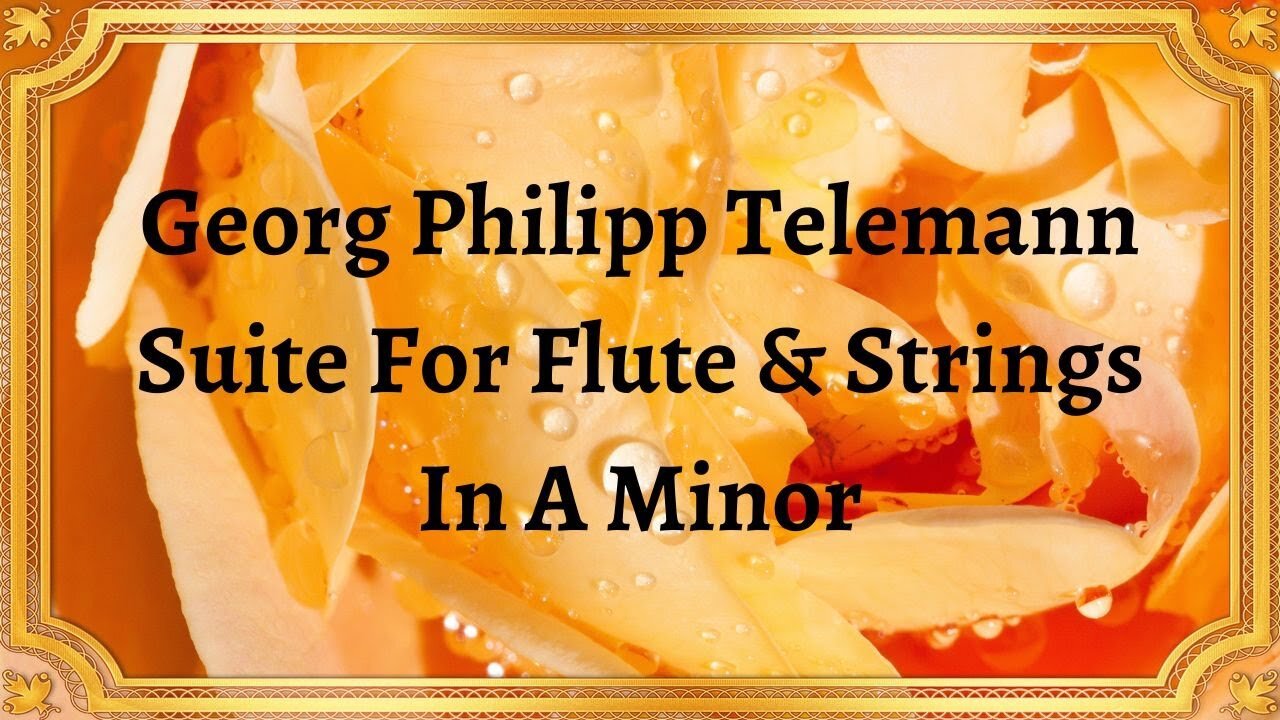Premium Only Content

Georg Philipp Telemann Suite For Flute & Strings In A Minor
#GeorgPhilippTelemann #SuiteForFluteAndStrings #AMinor #ClassicalMusic #MusicalComposition #Baroque #Flute #Strings #MusicAppreciation #MusicHistory #Composer #Musician #BaroqueMusic #MusicEnsemble #InstrumentalMusic #ChamberMusic #MusicPerformance #MusicEducation #MusicScholarship
Publication date 1951
The Zimbler Sinfonietta; James Pappoutsakis
In the vast and diverse realm of classical music, the compositions of Georg Philipp Telemann have left an indelible mark. Among his many remarkable works, the Suite for Flute & Strings in A Minor stands as a testament to Telemann's genius and innovation.
Georg Philipp Telemann, a renowned German composer of the Baroque era, was a prolific figure in the world of music. Composed in the early 18th century, the Suite for Flute & Strings in A Minor exemplifies Telemann's mastery of the era's musical conventions and his unique ability to infuse his compositions with a sense of individuality.
The Suite for Flute & Strings in A Minor consists of multiple movements, each exhibiting its own distinct character and musical exploration. Traditionally, a suite comprises several stylized dance movements, and Telemann's composition adheres to this convention. The suite typically includes movements such as the allemande, courante, sarabande, and gigue, showcasing Telemann's command of these dance forms.
Telemann's Suite for Flute & Strings in A Minor showcases his ingenuity in crafting memorable musical themes. Each movement unveils a new melodic motif or rhythmic pattern, which Telemann skillfully develops and transforms throughout the suite. The interplay between the flute and the accompanying strings creates a rich tapestry of sound, evoking a range of emotions from the listeners.
Telemann's suite exemplifies his ability to create expressive and emotionally evocative music. The slow and introspective sarabandes, for example, elicit a sense of melancholy and introspection, while the lively gigues infuse the composition with energy and joy. Telemann's use of dynamic contrasts, ornamentation, and harmonic progressions adds depth and nuance to the suite, captivating the listener's imagination.
The Suite for Flute & Strings in A Minor holds an esteemed place in classical music repertoire, remaining a staple for flutists and chamber ensembles alike. Telemann's innovative approach to orchestration, his mastery of counterpoint, and his seamless fusion of dance forms have inspired generations of musicians. This composition stands as a testament to Telemann's lasting impact on the development of Baroque music.
Conclusion:
Georg Philipp Telemann's Suite for Flute & Strings in A Minor continues to enchant audiences with its masterful composition and expressive melodies. Through its carefully crafted structure, thematic development, and emotional depth, the suite exemplifies Telemann's unique artistic vision and his ability to captivate listeners with his musical storytelling. As we immerse ourselves in the rich tapestry of this composition, we are reminded of Telemann's enduring legacy as a composer of the Baroque era and the timeless beauty of his musical creations.
You have the opportunity to support the channel https://destream.net/live/RadSiarAl/donate
-
 52:11
52:11
Classical music_Music Inspiration
16 days agoAlexandra Glazunov Excerpts from the ballet "Raymonda"
821 -
 2:04:59
2:04:59
LFA TV
1 day agoTHE RUMBLE RUNDOWN LIVE @9AM EST
48.5K6 -
 LIVE
LIVE
Major League Fishing
9 days agoLIVE! - Fishing Clash Team Series: Patriot Cup - Day 4
369 watching -
 10:02:37
10:02:37
Plan ₿ Forum
1 day agoWAGMI Stage – Lugano Plan ₿ Forum 2025 | Live from Lugano 🇨🇭
515K22 -
 34:37
34:37
vivafrei
4 hours agoLive from Lugano Switzerland, Plan B RECAP with Matt Kohrs! BOOYA!
32.4K9 -
 46:25
46:25
X22 Report
20 hours agoMr & Mrs X - DoEd Was Used To Brainwash The Children, Trump Shut It Down - EP 13
45.4K28 -
 26:51
26:51
efenigson
2 days agoSwitzerland: Still the Land of Freedom? Samuel Kullman | You're The Voice - LIVE from Lugano PlanB!
33.4K5 -
 1:07:25
1:07:25
Wendy Bell Radio
9 hours agoPet Talk With The Pet Doc
37.9K37 -
 4:45
4:45
PistonPop-TV
8 days agoMazda K-Series V6: Only True Enthusiasts Know About This Engine
27.4K4 -
 19:51
19:51
Stephan Livera
3 days ago $10.29 earnedStephan Livera hosts Plan B Podcast in Lugano
51.7K1